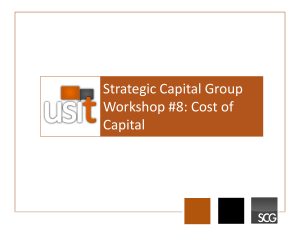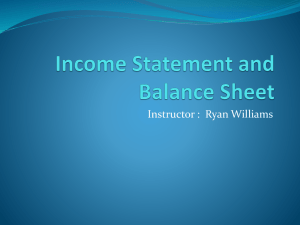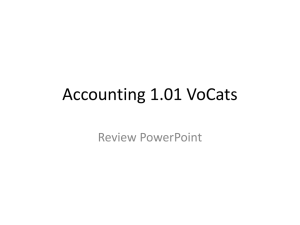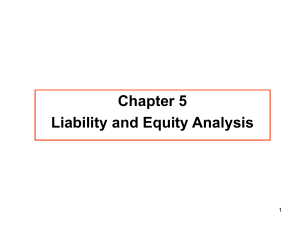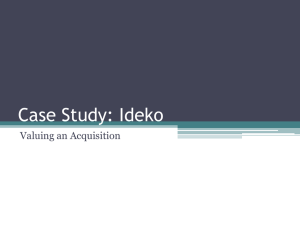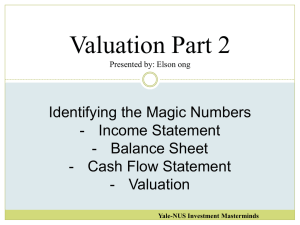Accounts Receivable
advertisement
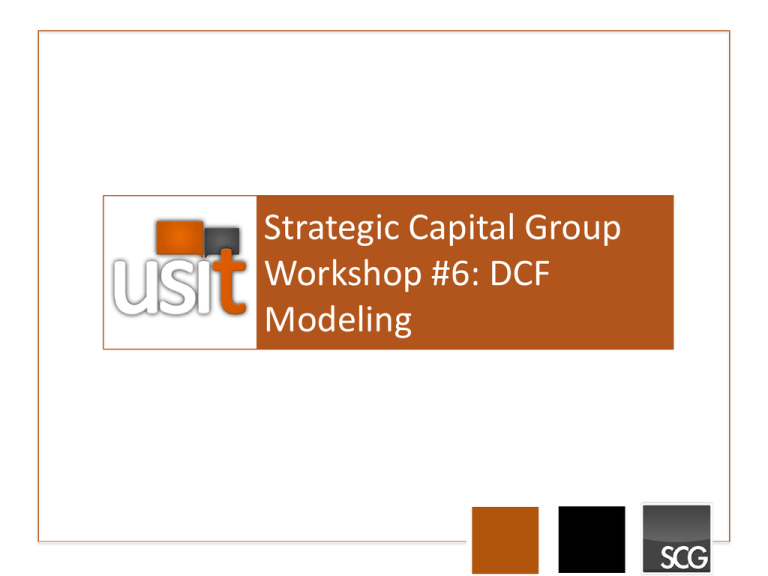
Strategic Capital Group Workshop #6: DCF Modeling Agenda Discounted Cash Flow Walkthrough Forecasting 101 Projection Walkthrough Net Working Capital and WACC Calculating Terminal and Equity Value Walkthrough of the DCF Please open up the DCF template in excel (found on the USIT Website) Revenue -COGS Gross Profit Line Items -SG&A Expenses -Other Expenses -R&D Expenses EBIT x(1-Tax) NOPAT +D&A -CapEx +Δ NWC FCF Proxy The Idea Behind It 1.) We are converting revenue to cash (due to accounting gimmicks making metrics like revenue and net income “tainted”). 2.) We project out revenue and the subtractions required to get to cash for the period of 5 years 3.) Discount the cash flows back to present value and add them back up 4.) Calculate an enterprise value by summing the PV’d cash flows 5.) Solve for equity value 6.) Divide equity value by shares outstanding to find implied share price The First Step: Forecasting • We need to figure out what the revenues and associated costs for the next 5 years will be in order to find what the cash flows will be for the next five years • Goal: To create a defensible argument for our projections • Several components to forecasting Why 5 Years? Reach a steady state – go through an economic cycle and realize any projects/initiatives Forecasting: Company Overview UNDERSTAND THE COMPANY UNDERSTAND THE COMPANY UNDERSTAND THE COMPANY Things to look at: • Management Philosophies (ex. Steve Jobs did a great job of innovating, good sign) • Products/Services (will people still use this product in the future, do people like it? Ex. NewsCorp’s print business) • Competition in the Industry (does the company risk others beating its product line ex. HP vs. Dell) • Where the company is going (Does the company want to reinvent itself? Ex. Dell moving toward enterprise and away from consumer PC’s) • What does it do? (Avoid critical mistakes like Microsoft selling PC’s, they sell OS’s, totally different markets) Forecasting: Company Overview • Where can I find this information? http://www.wikiwealth.com/swot - Company SWOT analysis (Strength, Weakness, Opportunity, Threat) 10-K and Annual report covers- Give a run down of the company, its business segments, who it sells to, what regions drive its revenue, how big it is 10-K Management Discussion & Analysis- Management gives its opinions on where it wants to take the company and its own SWOT Forecasting: Markets and Industries • Now that we’re nice and comfy with the company and know how it will make money, we need to figure out how much it will make. • We look at industry and market growth to try and understand wide trends that will benefit the company. Forecasting: Markets and Industries We have a number of sources to get information on markets and industries: -Capital IQ -FactSet -News Articles -Other industry report generating sources -academic.mintel.com These are the two best, tune into factset and CIQ workshops to learn how to use them effectively. Forecasting: Targets How do we know we’re close to picking the correct revenue amount? -Past History- typically we cap growth rates at their 5-10 year averages to be conservative. -Analyst Estimates- analysts will come out an give their forecasts for quarterly and annual revenue reporting, typically up to 5 years into the future. -MD&A- Management will typically come out set their EPS and Revenue targets for the 1-2 years in the future, then give a long term, 10 year goal. Forecasting: Targets • Past History: – Pros: give us the bounds of what a company is capable of achieving (a company that has grown only 1-2% in the past isn’t likely to see 30% YoY growth) – Cons: Past history isn’t always a measure of future performance, a new product or market can jump start aggressive growth Forecasting: Targets • Analyst Estimates: – Pros: Typically a large number of analysts that spend a lot of time tracking a company and understanding it- making some of their predictions fairly close – Cons: Some analysts work for in divisions of an Investment Bank and can be pressured to give a “buy” rating to company’s the iBank works with, so many times Analysts are a little too optimistic Forecasting: Targets • MD&A: – Pros: Since they run the company, there’s a good chance the direction they say they want to take the company is the direction it will go. Also very good at forecasting CapEx – Cons: Incentive to overstate their income and revenue predictions, typically they are a good benchmark for an aggressive prediction, rather than conservative. Forecasting: Digesting It All • So we understand the company’s offerings, where management thinks its going, where the market is going, past growth, and where analysts who have studied the company think it’s going. • We need to translate this into a growth rate. Forecasting: Digesting it All • Unfortunately there are no equations for translating qualitative information into an exact quantitative number, it’s something you have to practice and get good at. • However, we can get close to predicting a correct number. Filling in the Blanks • Let’s flip back to the DCF template and fill it in. • Start with the user inputs for the 2012 year (in gray boxes) • To save time, we will target Apple, a fairly known company. Key Revenue Drivers • What drives revenue? – Either Price must go up, or Quantity must go up – Or new products Costs • Not being able to use chinese sweatshop labor will drive up costs a little, but Apple will still probably do it a little. SG&A • We see Apple keeping its SGA& stable at its past average growth rate Other Operating Expenses • No R&D, No interest or other income. Capital Expenditures • Let’s look at MD&A for a good estimate for Capital Expenditures (purchases of long-term assets, found in the statement of cash flows investing section). In non-time constrained environments we would go back and check Management’s accuracy of predictions. Capital Expenditures • As a company matures, typically its Capital Expenditures tails off Depreciation • Depreciation is tied to long-term assets, (long-term assets are the only assets that generate depreciation expense, we don’t depreciate cash or accounts receivable). • We can look at a depreciation schedule in the 10k to figure out how much depreciation will come due from year to year and forecast that way, or tie it to CapEx growth (eventually D&A growth will tie to CapEx growth). • We add depreciation back to Revenue in order to eliminate non-cash expenses and get to a more accurate Free Cash Flow So where are we? • We’ve learned forecasting tools for revenues, costs, and learned the general form of a DCF’s line items. • We’ve gone over how depreciation and CapEx are forecasted and how they affect free cash flows. Change in Net Working Capital • Working Capital = Current Assets – Current Liabilities • We deal with non-cash current assets and non-interest bearing current liabilities • Represents operating liquidity of the business. • We add/ subtract this from Revenue due to the involvement of changes in current assets and liabilities to cash – We pay cash to increase current assets, and gain cash when current assets are sold, the inverse applies to liabilities • So if the change in NWC is positive, then we added more assets than liabilities so we subtract this from Revenue. If change in NWC was negative (more liabilities added than assets), this will increase the amount of cash we received during the period Net Working Capital • Flip to the NWC page on the DCF Template • Here we forecast out changes in major current assets: Accounts Receivable, Inventory, Prepaid Expenses and current liabilities: accrued liabilities and accounts payable • Not cash, want this to be independent of cash flows generated. Net Working Capital • Current Assets: – Accounts Receivable: customers paid on credit • Calculate DSO (Days Sales Outstanding) – (AR / Sales) * 365 – tells us how long it takes to collect a full A/R account – Inventory: RM, WIP, FG • Calculate DIH (Days Inventory Held) – (Inventory / COGS) * 365 –Tells us how long inventory spends in our warehouse before it is sold – Prepaid Expenses/Other: payments made before product given/service performed • Simply % Sales Net Working Capital • CLs: – Accounts Payable: amount company owes for credit purchases • Calculate DPO (Days Payable Outstanding) – (AP / COGS) * 365 – Average number of days it takes to make payment on outstanding purchases – Accrued Liabilities: ie wages payable, rent, interest, taxes • Simply % Sales Projecting an Account • We Project these by either holding the DSO/DIH/%Sales constant through time (or growing/shrinking it a little each year) and calculating what the account will look like based on our sales predictions. Projecting an Account If Days Sales Outstanding has been about 45 days for the past few years, we can be fairly confident it will remain 45. Accounts Receivable * 365 We projected revenue will go from 100M to 110M next year DSO = Sales So we know DSO (because we held it constant at 45 after some research), and sales (based on our revenue growth rates) so we can calculate A/R Accounts Receivable * 365 45 = = 13.5M 110M Projecting Accounts • We do the same with the rest of the current liabilities and assets • With percentages, we expect the assets value to be a % of revenue (or other account) so just look at that year’s projected account and take the percentage to find what the new current account value is. • Look at the year-over-year change value and take (sum of current asset changes) – (sum of current liabilities changes) to find the change in NWC. Check for Understanding Inventory Level this year: $100M Cost of Goods Sold this Year: $450M What is Days Inventory Held? DIH = (Inventory/COGS)*365 DIH = (100/450)* 365 DIH= 81 Check for Understanding If we forecasted $500M in COGS in 2013 and expected DIH to grow by 1 day each year, what will our inventory be in 2013? DIH = (Inventory/COGS)*365 82 = (Inventory/500)* 365 Inventory = $112.35M So change in inventory = 112.35M – 100M = 12.35M What is the change in Net Working Capital? Inventory grew from 2012 to 2013 by 12M Accounts Receivable decreased by 4M Prepaid Expenses grew by 1M Accrued Liabilities grew by 8M Accounts Payable grew by 13M (12+4+1) - (8+13) 17-20 -3M So what’s left? • We know what our revenue and costs will be over the next 5 years, we know NWC and the depreciation and CapEx. • We’ve reached free cash flow, but we need to figure out what the cash flows are worth today. We need to discount them back to the future. • But what discount rate do we use? How do we find an discount rate that reflects the diversity of risk within our specific company? Weighted Average Cost of Capital • What is it? • Essentially the weighted average rate a company expects to pay out to its financing sources (both debt and equity holders) • We use this rate as a discount rate for the cash flows. Weighted Average Cost of Capital Equation: WACC = %Debt x Cost of debt x (1-Tax Rate) + %Equity x Cost of equity Essentially: How much return all of our financiers get = How much return the equity holders demand * weighting of equity + How much return the debt holders demand/get * weighting of debt Cost of Debt In order to find what the company pays to its debt holders, we should find what the weighted average interest rate for their debt is (on the 10-K) We then weight the average interest rate they pay (by multiplying it by what percentage of their capital comes from debt capital) then multiply it again by (1-tax rate) to adjust for the tax deductibility of interest expense. (Average Interest Rate * %debt) * (1-tax Rate) Check for Understanding • So what is the cost of debt for a company that has all of its money from equity holders? 0! If we don’t have any debt, then we don’t care about debt financing costs. (Average Interest Rate * %debt) * (1-tax Rate) Check for Understanding • If a company’s credit rating goes down, what happens to its cost of debt? (Average Interest Rate * %debt) * (1-tax Rate) HINT: a decrease in credit rating will drive up your average interest rate Cost of debt will increase Cost of Equity Market Premium = Return in the Equity market (Rm) – Risk-Free Rate (Rf) Essentially how much an extra return an investor gets for taking on equity risk. Can take a 5-20 year average of S&P or DOW’s returns or just a 1 year. 10- Year Treasury Yield (Market Premium * Beta) + Risk-Free Rate = Cost of Equity Adjusting the equity returns for risk Typically a long term beta Check for Understanding • If the returns in the equity market increases, what happens to a company’s cost of equity? Market Premium = Return in the Equity market (Rm) – Risk-Free Rate (Rf) (Market Premium * Beta) + Risk-Free Rate = Cost of Equity It increases, since now in order to compete for financing dollars through equity, the company must effectively yield more returns to entice investors. WACC So what is the calculation for it? (Cost of Debt * % of capital that comes from debt) * (1-tax Rate) +Cost of Equity * % of capital from equity Weighted Average Cost of Capital • What influences it? – Market Interest Rates – Company Volatility (beta) – Equity market returns – Risk-free rates – Tax rates STOP! • We just learned how to calculate WACC, the value we will be using for our discount rate. • IT IS IMPERATIVE YOU YELL AT ME AND ASK QUESTIONS! Discounting We use the PV equation to discount each cash flow back to its present value. Remember: PV = (FV/ (1+ Discount Rate) ^ years away) Discounting • We’re still missing part of the value of the company, the company wont stop functioning after 5 years, technically we need to do this for the entire life of the company to find what the company is worth. • We call the estimation of a company’s cash flows from t=5 to t= infinity its “terminal value” Critical Thinking • If we’re taking the PV of an infinite number of years’ cash flows, shouldn’t the PV end up being infinity? No- as you get further and further into the future, a dollar becomes worth less and less until it eventually becomes worth nothing. Terminal Value • 2 ways to calculate this: – Exit Multiple Approach – Long-term growth rate approach Terminal Value: The Exit Multiple Approach • We can multiply the 5th year’s cash flow by a multiple of EV/EBITDA we plan to sell the company at in the future, then discount it back at year 5. Terminal Value = 5th Year Cash Flow * Projceted (EV/EBITDA) Terminal Value: The Exit Multiple Approach • We discount this terminal value back to the present value using year=5, not infinity. Calculated FV Terminal Value PV Terminal Value = (1+Discount Rate) ^5 Terminal Value: The Long-Term Rate • We can also calculate terminal value by figuring out the “long-term growth rate” of a company- essentially the amount we expect a company to grow consistently in the future once it has matured. Typically this number is just slightly larger than US or world GDP growth. 5th Year Cash Flow * (1+LT Rate) Terminal Value = Discount Rate – LT Rate Enterprise Value • Stepping aside, we need to discuss another way to measure the size of a company. • Previously we said market cap was a way to size a company (Price * shares outstanding) • But this had the issue of not taking into account the debt that was used to fund a company. • We adjust for this problem by calculating Enterprise Value Enterprise Value • EV is essentially the amount of money you would have to pay to “take over” a company, buying all of its debt and equity. EV = Market Cap + Debt – Cash +Preferred Shares + Minority Interest We take out cash because when we buyout a company, we are paying cash for cash, which cancels out. Here we are taking into account nonequity shares we have to buyout Getting to Enterprise Value from Cash Flows After discounting the terminal value and the FCF’s from the 5 projected years, we add them all up to reach our implied Enterprise Value. From this, we solve for market cap by taking out debt, preferred shares, and minority interest, leaving us with Market Cap + Cash. We divide this value by the shares outstanding to find the implied price per share.


